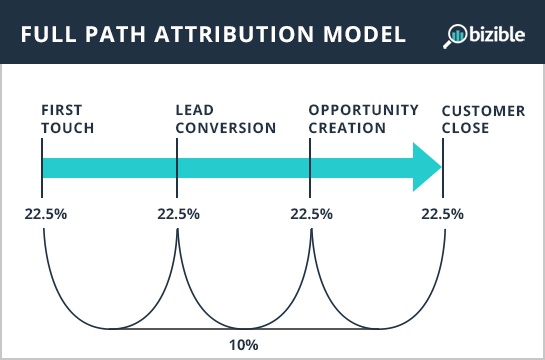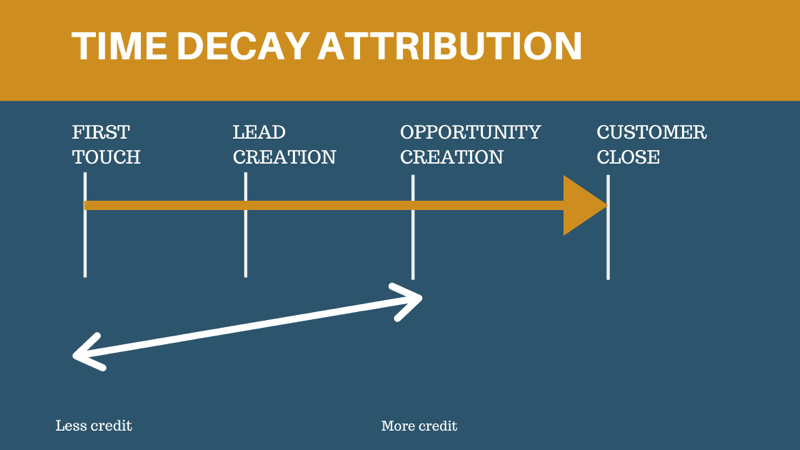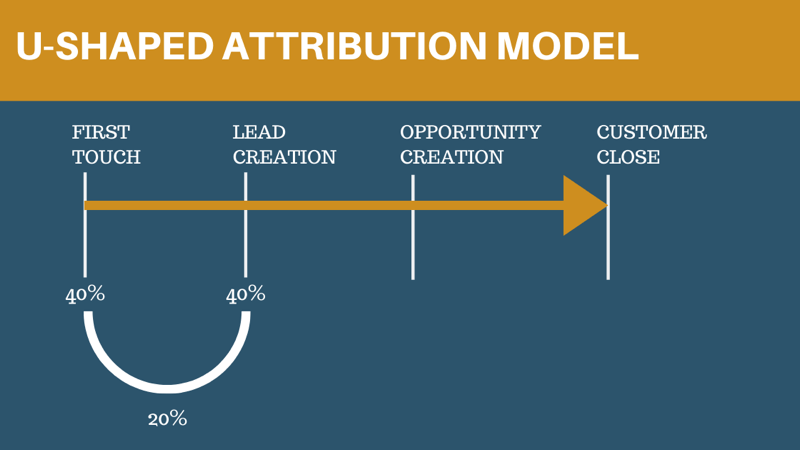An attribution model in marketing is a strategy used to measure the effectiveness of different touchpoints within the customer journey. By using an attribution model, marketers can accurately assess how various marketing channels contribute to each sale or conversion.
Attribution models also help marketers allocate their budgets more efficiently, as they provide insight into which channels are most effective for driving conversions. Businesses can adjust their strategies based on the data collected from different customers and their unique paths to purchase.
But most importantly, attribution models tell you which channels and strategies are contributing most to your bottom line.
Here’s how the right attribution model can help you identify the best strategies for generating revenue and improving your bottom line so you can better allocate your marketing spend.
How Do You Choose the Best Attribution Model?
Choosing the right attribution model for measuring your marketing can be a difficult task. As we’ll explore, that are many different models to choose from, and they each tell you something specific about your marketing strategies.
To make an informed decision, you must have a clear understanding of all available models and how they differ. It is also important to consider the customer journey, objectives, and KPIs when selecting an attribution model as different models measure different aspects of customer behavior.
For example, the time decay attribution model gives more weight to touchpoints closest to conversion. That means they provide a better understanding of how your most recent interactions with prospects influence sales. By contrast, a first touch attribution model assigns credit for conversions and sales to the first touchpoint in the customer journey.
8 Attribution Models to Use in Your Campaigns
To give you a better idea of which attribution models to use, we’ll explore eight different types of attribution models and what they can tell you about your campaigns.
1. First Touch
As noted, a first touch attribution model assigns credit for conversions and sales to the first touchpoint in the customer journey. This is a single-touch attribution model in that it doesn’t assign any credit to other touchpoints.
That first touchpoint could be the first click on one of your ads, the first visit to your website, or even the first impression on one of your social media posts.

(Source: Social Media Examiner)
In the example above from Social Media Examiner, 100% of the credit for the customer close is assigned to the first touch.
There are pros and cons to using this model. It’s an easy model to set up, and it’s a good model for analyzing your top-funnel marketing strategies and identifying which ones bring in the most business.
That said, this model won’t tell you much about the customer journey itself. There’s also a risk of errors, as not every first touchpoint makes a significant enough impression to lead to a closed sale. You can’t always say for sure that the first touch is what led the customer to make a purchase, either.
2. Last Touch
A last-touch attribution model assigns credit for conversions to the last customer interaction before a sale. This model allows both marketers and salespeople to gain insight into how effective their final campaigns are in terms of driving sales.

(Source: Social Media Examiner)
As you can see in the example above, 100% of the credit is assigned to the final touchpoint before the customer makes a purchase.
There are pros and cons to this attribution model as well. The benefit is that it identifies exactly what led your prospect to convert into a customer. This makes it a useful tool for identifying winning sales strategies and bottom-funnel marketing channels.
However, like the first touch model, this model excludes every touchpoint leading up to the final one before the sale. It won’t tell you whether your drip campaigns or your content helped close the sale, for example. It doesn’t give you a full picture of the customer journey.
3. Linear/Multi-Touch
A linear attribution model is a multi-touch model that assigns equal credit for conversions to all customer touchpoints in the customer journey. This model offers much more balanced insights into the entirety of the customer journey compared to first-touch and last-touch models.

(Source: Social Media Examiner)
In the example above, each touchpoint is given equal weight for the close of the deal based on how many touchpoints resulted in a close. For example, if there were five touchpoints throughout the customer journey, each touchpoint would receive 20% of the credit for the sale.
While this may seem counterintuitive, it provides useful insights when you use this model for multiple closed deals. By compiling the data, you’ll start to notice trends among your touchpoints based on which were successful and which weren’t in converting customers.
The main downside to this approach is the reality that not all touchpoints are equal. For example, this model may assign the same credit to a social media comment as it would to a digital ad campaign. It doesn’t necessarily tell you what, exactly, made the customer decide to convert.
4. Full Path
Like the linear model, the full path attribution model assigns credit for conversions to all customer touchpoints in the customer journey. However, this model assigns relative importance to each of the steps a customer takes before they convert, such as visiting a website, reading an email, or getting referred by a friend.
By attributing each step with its relative importance, marketers can better understand how their campaigns are impacting sales and optimize accordingly.

(Source: Business 2 Community)
The full path attribution model has several advantages, including the ability to get an accurate understanding of the customer journey and optimize campaigns accordingly. It also helps recognize marketing efforts that may have previously gone unrecognized.
However, this model can be difficult to implement as it requires detailed analysis and can be time-consuming. Certain channels may also be overlooked if they are not part of the conversion process.
5. Time Decay
A time decay attribution model assigns credit for conversions based on the recency of each customer touchpoint. This model gives more weight to recent customer interactions and less weight to previous interactions, thereby assigning more credit for conversions that occur shortly after an interaction.

(Source: Social Media Examiner)
The advantage of this model is that it allows you to prioritize efforts based on what will give the most immediate return. It also helps you recognize important late-stage touchpoints that often go unrecognized with other models, such as bottom-funnel marketing and sales strategies.
On the downside, this model does not consider all customer interactions and fails to recognize those efforts that do not lead directly to conversions. In long B2B sales cycles, a customer may wait months after an initial touchpoint before converting—that doesn’t necessarily mean that the initial touchpoint shouldn’t be assigned credit.
6. J-Shaped
The J-shaped attribution model attributes most of the credit to the final conversion touchpoint, but it also provides attribution for the first touchpoint and all those in between.

(Source: HubSpot)
According to HubSpot, the model “attributes 20% of the credit to the first interaction, 60% to the conversion,” while “the remaining 20% is spread across other interactions in the conversion path.”
This model is advantageous because it helps marketers understand which channels are driving the initial awareness and influence of customers, but it places a higher emphasis on the most important channels and strategies that are generating conversions. The one downside to this model is that it isn’t as effective in helping marketers identify mid-funnel touchpoints that are contributing to the sale.
7. Reverse J-Shaped
The reverse J-shaped attribution model works similarly to the J-shaped attribution model, but it attributes most of the credit to the initial touchpoint rather than the last. It also assigns some credit to the touchpoints between the two.

(Source: HubSpot)
Like the J-shaped model, this model is useful for identifying effective initial touchpoints while still assigning credit to the touchpoints in between as well as the final touchpoint. Once again, the only real downside to this model is that it isn’t an effective tool for identifying mid-funnel touchpoints that are producing conversions.
8. U-Shaped
The U-shaped attribution model assigns 40% of the credit to both the first and last touchpoints in the customer journey, but it also assigns 20% to the middle touchpoint. This makes it a good tool for identifying winning top-funnel marketing strategies as well as those final touchpoints that contribute most to sales.

(Source: Social Media Examiner)
This model emphasizes the fact that the first point of interaction with a customer is just as important as the last point of interaction. It also provides some insight into which touchpoints in the middle of the journey are helping to produce the most conversions.
This model is particularly useful, but it may not be appropriate in every circumstance. Sometimes, the first or last touchpoint isn’t as important as the other.
Get More Insights About Your Bottom Line
Choosing an attribution model can be challenging, but it helps to apply a few to your marketing data to see what types of results you generate. You should also consider what type of business you operate when making your decision.
For example, you may use an advertising strategy to generate a high level of first impressions with customers, but you may only close a few sales that began with that advertising campaign. This would imply that the middle and final touchpoints in the customer journey require more emphasis than the first touchpoint.
To learn more about how to apply these and other attribution models, contact us at Aptitude 8.






